Intel Core i5-12490F Review: China's Exclusive 'Black Edition' Gaming Chip
China's exclusive Alder Lake chip targets internet cafes

Intel's Core i5-12400 is the acclaimed go-to recommendation for budget builds, but the company has also crafted a souped-up ~$250 'Black Edition' Core i5-12490F variant specifically for the China market, ostensibly for the internet cafes where gaming reigns supreme. Intel hasn't publicly announced this chip and it still isn't listed on the company's public-facing databases, making even getting the basic specs for the six-core 12-thread chip a challenge. However, we managed to snag a 12490F from a retail outlet in China to see how it stacks up against the Best CPUs for gaming in our CPU benchmark hierarchy. The 12490F also gives us a chance to study Alder Lake's different die types.
Intel's relentless segmentation finds the company chopping its foundational silicon designs up into a wide array of regimented products, so purpose-built SKUs aren't entirely new. However, China-only models are rare — Intel's Pentium E6500K, the company's first overclockable "K" series chip, launched exclusively in China in 2009 as an experiment. Intel followed that with the introduction of the K-series models in the US in May 2010, marking the launch of a series that has generated untold billions in revenue for the company.
Intel's China-exclusives haven't always been so rosy, though: The infamous Core i3-8121U was the last consumer chip that Intel confined to China, but that was to hide the poor-yielding nature of the company's then-inherently-flawed 10nm silicon. Intel wrapped those chips in a laptop and NUCs, but most theorize the company was merely hiding its defective Cannon Lake silicon in China to deliver on its promise to investors that it would finally ship 10nm chips by the end of 2017.
Honestly, that whole saga didn't end well — Intel killed the Cannon Lake family, not to mention its inaugural 10nm process, after that one China-exclusive model. Now, here we are four years later with the Core i5-12490F that's fabbed on the fourth-gen of that 10nm process, though Intel now calls it 'Intel 7' instead of its original '10nm Enhanced SuperFin' moniker.
The name really doesn't matter, though, as Intel has put all of the nastiness of its first 10nm revision far in the rearview (heh), and the Intel 7 process paired with Intel's new x86 hybrid Alder Lake architecture has catapulted the company back to the top of the desktop PC market after a few tough years of trailing AMD.
| Row 0 - Cell 0 | Price | Cores | Threads | P-Core Base/Boost | E-Core Base/Boost | TDP / PBP / MTP | DDR4-3200 | L3 Cache |
| Core i9-12900K / KF | $589 (K) - $564 (KF) | 8P + 8E | 16 Cores / 24 Threads | 3.2 / 5.2 GHz | 2.4 / 3.9 GHz | 125W / 241W | DDR4-3200 / DDR5-4800 | 30MB |
| Core i7-12700K / KF | $409 (K) - $384 (KF) | 8P + 4E | 12 Cores / 20 Threads | 3.6 / 5.0 GHz | 2.7 / 3.8 GHz | 125W / 190W | DDR4-3200 / DDR5-4800 | 25MB |
| Core i5-12600K / KF | $289 (K) - $264 (KF) | 6P + 4E | 10 Cores / 16 Threads | 3.7 / 4.9 GHz | 2.8 / 3.6 GHz | 125W / 150W | DDR4-3200 / DDR5-4800 | 20MB |
| Core i5-12490F | ~$250 | 6P + 0E | 6 Cores / 12 Threads | 3.0 / 4.6 GHz | n/a | 65W / 117W | DDR4-3200 / DDR5-4800 | 20MB |
| Core i5-12400 / F | $192-$199 | $167-$174 (F) | 6P + 0E | 6 Cores / 12 Threads | 2.5 / 4.4 GHz | n/a | 65W / 117W | DDR4-3200 / DDR5-4800 | 18MB |
| Core i3-12100 / F | $122 - $129 | $97 - $104 | 4P + 0E | 4 Cores / 8 Threads | 3.3 / 4.3 GHz | n/a | 60W / 89W | DDR4-3200 / DDR5-4800 | 12MB |
- Intel Core i9-12900K vs Ryzen 9 5900X and 5950X: Alder Lake and Ryzen 5000 Face Off
- Intel Core i5-12600K vs AMD Ryzen 5 5600X and 5800X Face Off: Ryzen Has Fallen
- Intel Core i7-12700K vs AMD Ryzen 9 5900X and 5800X Face Off: Intel Rising
- Intel Core i5-12400 vs AMD Ryzen 5 5600X Face-Off: The Gaming Value Showdown
In fact, that's what makes this China-exclusive chip so interesting. For now, Intel is basically unchecked in the budget segment, adding to the company's newfound dominance with the Alder Lake chips that even outperform more expensive Ryzen 5000 chips, so the company definitely doesn't need to hide any of its chips away in China.
Intel could easily charge higher premiums for its silicon, and that might be part of the impetus for the Core i5-12490F. Unlike Intel's other unlocked chips, it doesn't come in a blue box with a stock cooling fan: Instead, you get a black box without a bundled cooler, which probably saves Intel at least some coin. Like all of Intel's standard F-series chips, you also don't get functional graphics with the 12490F, but in what isn't a standard practice, that doesn't save you any cash like it does with Intel's other F-series models.
Intel Alder Lake Core i5-12490F Specifications and Pricing
| Row 0 - Cell 0 | Price | Cores | Threads | P-Core Base/Boost | E-Core Base/Boost | TDP / PBP / MTP | Memory Support | L3 Cache |
| Ryzen 5 5600X | $299 | 6P | 12 threads | 3.7 / 4.6 GHz | - | 65W | DDR4-3200 | 32MB |
| Ryzen 5 5600G | $259 | 6 / 12 | 3.9 / 4.4 | - | 65W | DDR4-3200 | 16MB |
| Core i5-12600K | $289 (K) - $264 (KF) | 6P + 4E | 10 Cores / 16 Threads | 3.7 / 4.9 GHz | 2.8 / 3.6 GHz | 125W / 150W | DDR4-3200 / DDR5-4800 | 20MB |
| Core i5-12600 | $223 | 6P + 0E | 6 Cores / 12 Threads | 3.30 / 4.8 GHz | n/a | 65W / 117W | DDR4-3200 / DDR5-4800 | 18MB |
| Core i5-12500 | $202-$212 | 6P + 0E | 6 Cores / 12 Threads | 3.0 / 4.6 GHz | n/a | 65W / 117W | DDR4-3200 / DDR5-4800 | 18MB |
| Core i5-12490F | ~$250 | 6P + 0E | 6 Cores / 12 Threads | 3.0 / 4.6 GHz | n/a | 65W / 117W | DDR4-3200 / DDR5-4800 | 20MB |
| Core i5-12400 / F | $192-$199 | $167-$174 (F) | 6P + 0E | 6 Cores / 12 Threads | 2.5 / 4.4 GHz | n/a | 65W / 117W | DDR4-3200 / DDR5-4800 | 18MB |
| Ryzen 5 3600X | $240 | 6 / 12 | 3.8 / 4.4 | - | 95W | DDR4-3200 | 32MB |
| Ryzen 5 3600 | $200 | 6 / 12 | 3.6 / 4.2 | - | 65W | DDR4-3200 | 32MB |
| Core i3-12100 / F | $122 - $129 | $97 - $104 | 4P + 0E | 4 Cores / 8 Threads | 3.3 / 4.3 GHz | n/a | 60W / 89W | DDR4-3200 / DDR5-4800 | 12MB |
We bought the chip for roughly $250 at a Chinese retailer (after conversion and before shipping costs), but the two bookend processors, the Core i5-12400F and Core i5-12500, both cost far less than the 12490F at $167 and $202, respectively, and have very similar specifications. In fact, even the Core i5-12600 is less expensive even though it comes with higher clock rates.
The primary attraction for the Core i5-12490F still obviously remains the clock rates, which are slightly higher than the 12400, and its 20MB of L3 cache, which is 2MB more than the 18MB found on the rest of Intel's locked (not overclockable) Core i5 chips. In fact, that's the only attribute that differentiates the 12490F from the 12500, as they both have identical clock rates.
Get Tom's Hardware's best news and in-depth reviews, straight to your inbox.
| Active Cores | 1-2 | 3-4 | 5-6 | Base Clock |
| Core i5-12490F | 4.6 GHz | 4.4 GHz | 4.0 GHz | 3.0 GHz |
| Core i5-12400 / F | 4.4 GHz | 4.2 GHz | 4.0 GHz | 2.5 GHz |
The Core i5-12490F has a 500 MHz higher base clock than the Core i5-12400, but that isn't too meaningful — you'll basically never see that clock rate if you use a high-performance power profile in Windows. And while the 12490F has a 200 MHz higher peak dual-core boost clock rate than the popular Core i5-12400, as you can see in the table above, they have the same all-core boost rate. The Core i5-12490F also has the same 65W PBP (base) and 117W MTP (peak) power rating.
That means the chips will perform very similarly in threaded workloads, but the 12490F will have an edge in lightly-threaded tasks and applications that benefit from its extra 2MB of L3 cache.
Otherwise, the 12490F is the same as the other locked (not overclockable) Core i5 models (more details here). The higher-end Alder Lake chips have big and fast Performance cores (P-cores) for latency-sensitive work paired with clusters of small and powerful Efficiency cores (E-cores) that chew through background processes. However, the locked Core i5 models don't have a hybrid architecture; instead, they have a more traditional design with only six P-Cores active. That means the six-core 12-thread processors don't need Intel's new Windows 11-exclusive Thread Director technology, so unlike Intel's hybrid models, the Core i5 models are just as potent in Windows 10 as they are in Windows 11. As always, going with an F-series chip means you will lose Quick Sync capabilities and the iGPU fallback that you can use for troubleshooting in the event of an issue with a discrete GPU.
Alder Lake's performance advantages come even without its support for DDR5 memory and PCIe 5.0 interfaces (both of which Intel brought to market first). As such, you can use standard DDR4 memory and PCIe 4.0 devices and still have superior performance and connectivity options over AMD's aging AM4 platform. There are also plenty of B- and H-series boards that leverage less-expensive DDR4 memory, which is a saving grace given the ongoing DDR5 shortages.
So why did Intel choose to release the 12490F to the China market? That's hard to say, but the company does charge a decent premium for a rather small difference between the 12490F and its siblings, like the 12500. In fact, the 12500 doesn't have an F-series model, making one wonder if that is the 12490F's true role, but the different cache allocation, special branding, and lack of a bundled cooler all point to another purpose. Besides, we don't see an F-series Core i3-12300, either, so Intel does have a tendency to skip F-series models on some Alder Lake variants.
Perhaps this careful segmentation could simply serve to build the company's brand in China — it does come a few years after AMD launched its own China-exclusive Ryzen 5 3500X and AMD 4700S Desktop Kit, both of which have passed through our lab. However, the 12490F doesn't compete against those now-aging Zen 2-powered chips.
Intel Core i5-12490F and Core i5-12400 Die Details

Intel uses two different dies for the Alder Lake series: One die has eight P-cores and eight E-cores (8P+8E) and is a C0 stepping die, while the other has just six P-cores (6+0) and is an H0 die. Obviously, the latter die is much smaller and thus more cost-effective, therefore making far more sense for use in the non-hybrid Alder Lake chips with six or fewer cores.
That means that while all Core i9 and i7 models come with the C0 8+8 die, most Core i5, i3 and lower SKUs use the H0 6+0 die — but Intel can use either die for its smaller chips. Naturally, that helps the company sell larger dies that encounter defects during manufacturing. It could also help improve supply and manufacturing efficiency when there aren't enough 'perfect' defect-free 6+0 dies available. Both die come with 32EUs based on the Xe LP architecture, but those iGPU units are chopped up for segmentation purposes.
That means the locked Core i5 chips can vary on a chip-to-chip basis and come with either die type. C0 stepping chips like our 12490F actually have a total of eight P-cores and eight E-cores, but Intel disables the extra cores to trim it down to a 6+0 design.
As you can see in the first image in the below album, the 8+8 C0 die on our 12490F has more capacitors/SMDs on the bottom of the chip than the 6+0 H0 die in our 12400, a necessity to deliver the additional power to the two extra P-cores and two four-core clusters of E-Cores (8 total physical E-cores) that aren't present on the smaller die.


As depicted in the left-most diagram in the second image, the 8+8 C0 dies have 30MB of total L3 cache onboard, divided into ten 3MB slices of L3 cache distributed among the eight P-cores and two four-core clusters of E-cores.
Intel hasn't released a diagram of the 6+0 desktop die, but these chips have a maximum capacity of 18MB of L3 cache because they have only six physical P-cores, each with a 3MB slice of L3, and no E-cores (or their associated L3 slices).
As a result, Intel has to use the 8+8 C0 die to craft the 12490F with 20MB of L3 cache, but on the surface, that seems counterintuitive: In the past, Intel has disabled cores and L3 slices in pairs, but that obviously doesn't apply here as the six-core 12490F would only have 18MB of cache. Also, 20MB of cache can't be evenly split among six cores/slices.
With Alder Lake, Intel has switched to a new approach to L3 cache distribution. The company no longer disables the L3 cache slices in lockstep with disabled cores, so all L3 cache slices stay enabled regardless of the number of active cores. Instead, Intel simply disables banks of cache within each L3 slice, meaning that each of the ten L3 slices on the 12490F's C0 die has 2MB of cache enabled. Naturally, that will result in different cache behavior than we would see with a fully-enabled chip with 30MB of L3 (and thus 3MB of L3 associated with each core/cluster).
We now have two Core i5-12400s in the test lab for comparison, one with a C0 die and one with an H0 die, but our retail H0 die model refuses to run the spec'd DDR4-3200 memory in Gear 1 mode for some unknown reason, restricting our ability to compare performance and latency. We're working on troubleshooting that issue so we can post a breakout article covering the differences between the two dies. For now, we can pull accurate power measurement tests, which you should check out in our power testing section after the main test suite -- we also dive into the power consumption differences between C0 and H0 chips.
Test Setup
The Core i5-12490F has the SRL4X S-spec. We tested with Windows 11 and DDR4 memory on a Z690 motherboard to maintain a comparable test environment with the rest of the processors in the test pool. Of course, you wouldn't pair this chip with this class of motherboard, but the 600-series B- and H-series motherboards also support memory overclocking and power limit adjustments. Given the 12490's relatively tame power consumption, even lower-end motherboards will provide the chip with enough juice for full operation, even with the power limits removed. We used DDR4 memory for testing, as current DDR5 pricing is too high for this class of chip.
The Core i5-12490F is a locked chip, but you can overclock the memory on Z- and B-series motherboards. We've seen easily-attainable memory overclocking ceilings stretch up to DDR4-4000 in Gear 1 with the unlocked overclockable Alder Lake chips, but it normally takes extra System Agent (SA) voltage to get there. You won't get that with the locked chips, though.
For unknown reasons, as we've seen with all of Intel's locked chips, the company has left the 12490F's System Agent voltage locked, meaning you can't change the default voltage. That's disappointing, to say the least: Bumping up the SA voltage is critical to improving memory overclocking on the Alder Lake chips. Our inability to adjust this value severely restricts DDR4 memory overclocking in Gear 1 mode (SA isn't as critical for DDR5 overclocking).
As you can see below, we were only able to gain an extra 400 MHz through memory overclocking in Gear 1, and as we've covered, running DDR4 in Gear 2 mode is not optimal for the overwhelming majority of workloads (especially gaming). It is encouraging that Intel has enabled memory overclocking on locked chips, but the company's decision to restrict SA voltage manipulation is nonsensical and ruins the value prop of memory overclocking with affordable DDR4 memory.
The Core i5-12490F isn't listed on motherboard compatibility lists, so we verified with MSI that the chip works as intended on the MSI Z690A WiFi DDR4 motherboard we used for testing. Additionally, we verified that the chip operated at the correct multi-core frequencies. We tested with secure boot, virtualization support, and fTPM/PTT active to reflect a properly configured Windows 11 install. We have a full breakdown of the test system configurations at the end of the article. We tested the Core i5-12490F in two different configurations:
- Core i5-12490F DDR4-3600: Corsair H115i 280mm water cooler, power limits removed, memory overclocked to DDR4-3600 in Gear 1 mode (Gear 2 results in performance regressions)
- Core i5-12490F: Intel recommended stock power limits (65/117W), Stock DDR4-3200 in Gear 1
Intel Core i5-12490F Gaming Benchmarks — The TLDR
As usual, we're testing with an Nvidia GeForce RTX 3090 to reduce GPU-imposed bottlenecks as much as possible, and differences between test subjects will shrink with lesser cards or higher resolutions. You would never see the Core i5-12490F paired with an RTX 3090, but this allows us to highlight unrestrained chip performance. Because most of the titles below show little meaningful differentiation at higher resolutions, we only tested four of the seven titles at 1440p.




We paired the Core i5-12490F with affordable DDR4 memory for our testing. We removed the 12490F's power limits and overclocked the memory for the 'Core i5-12490F DDR4-3600' entry, but only registered a 1.9% improvement over the stock config in our cumulative measurements at 1080p. That means you won't benefit much from investing in a more expensive memory kit, largely due to Intel's inexplicable practice of allowing memory overclocking on locked chips while leaving the System Agent voltage locked, thus restricting memory overclocking headroom.
The Core i5-12490F could use some help differentiating itself, though: The stock 12490F is only 2.6% faster than the stock 12400 at 1080p, but removing the power limits and tuning the memory on both chips leaves the 12490F with a scant 1.2% lead over the 12400. That's hardly worth the $50 premium, not to mention that you also sacrifice the 12400's Laminar RM1 stock cooler (Intel's stock cooler is actually decent this generation).
That isn't to say the Core i5-12490F isn't just as impressive as the 12400, though. The previous-gen Core i9-11900K flagship at stock settings is only 1.3% faster than the stock Core i5-12490F, but they effectively tie after tuning the 12490F. However, the Core i5-12400 is also impressive against the 11900K, but for significantly less cash.
| Tom's Hardware | 1080p Game Benchmarks - fps percentage |
| Core i5-12600K DDR4 | 100% |
| Core i5-12490F | 98.7% |
| Core i5-12400 | 97.1% |
| Ryzen 5 5600X | 95.4% |
| Core i5-11600K | 88.9% |
| Core i3-12100 | 86% |
| Ryzen 5 5600G | 81.1% |
| Ryzen 5 3600X | 75% |
| Ryzen 3 3300X | 72.1% |
| Core i3-10100 | 66.2% |
Naturally, moving over to 1440p brings a GPU bottleneck into the equation, so the performance deltas between the chips shrink tremendously. Flipping through the 99th percentile charts for both resolutions also shows larger deltas, but we have to view those with caution as Windows 11 seems to suffer from more framerate variability than our Windows 10 test platform.
Given the 12490F's similarity to the Core i5-12400, it has a very similar standing in our performance rankings relative to AMD's competing chips, though we do see the slight performance advantages over the 12400 that we would expect from a relatively small 200 MHz clock speed increase and slightly more cache.
However, the $199 Core i5-12400 is the mid-range gaming champion, continuing to offer a superior level of performance and a better platform, and that's despite AMD's price cuts that have found the Ryzen 5 5600X on shelves for around $225. In contrast, the Core i5-12490F's ~$250 pricing isn't nearly as competitive, especially given that the chip isn't available in the US and you'll have to pay for international shipping.
The Core i5-12490F is great for collectors, but most gamers are better off buying the Core i5-12400 and spending the extra cash on other additives. As usual, be aware that large performance deltas in a few of the game titles can heavily impact cumulative performance measurements above. It's always best to make an informed decision based on the types of titles you play frequently, so be sure to check out the individual game benchmarks below. Given the close similarity between the 12490F and the 12400, we'll skip commentary for the individual game titles.
3DMark, VRMark, Chess Engines on Intel Core i5-12490F





Synthetic benchmarks don't tend to translate well to real-world gaming, but they do show us the raw amount of compute power exposed to game engines. It's too bad most games don't fully exploit it.
Far Cry 6 on Intel Core i5-12490F


F1 2021 on Intel Core i5-12490F




Hitman 3 on Intel Core i5-12490F


Horizon Zero Dawn on Intel Core i5-12490F




Microsoft Flight Simulator 2021 on Intel Core i5-12490F

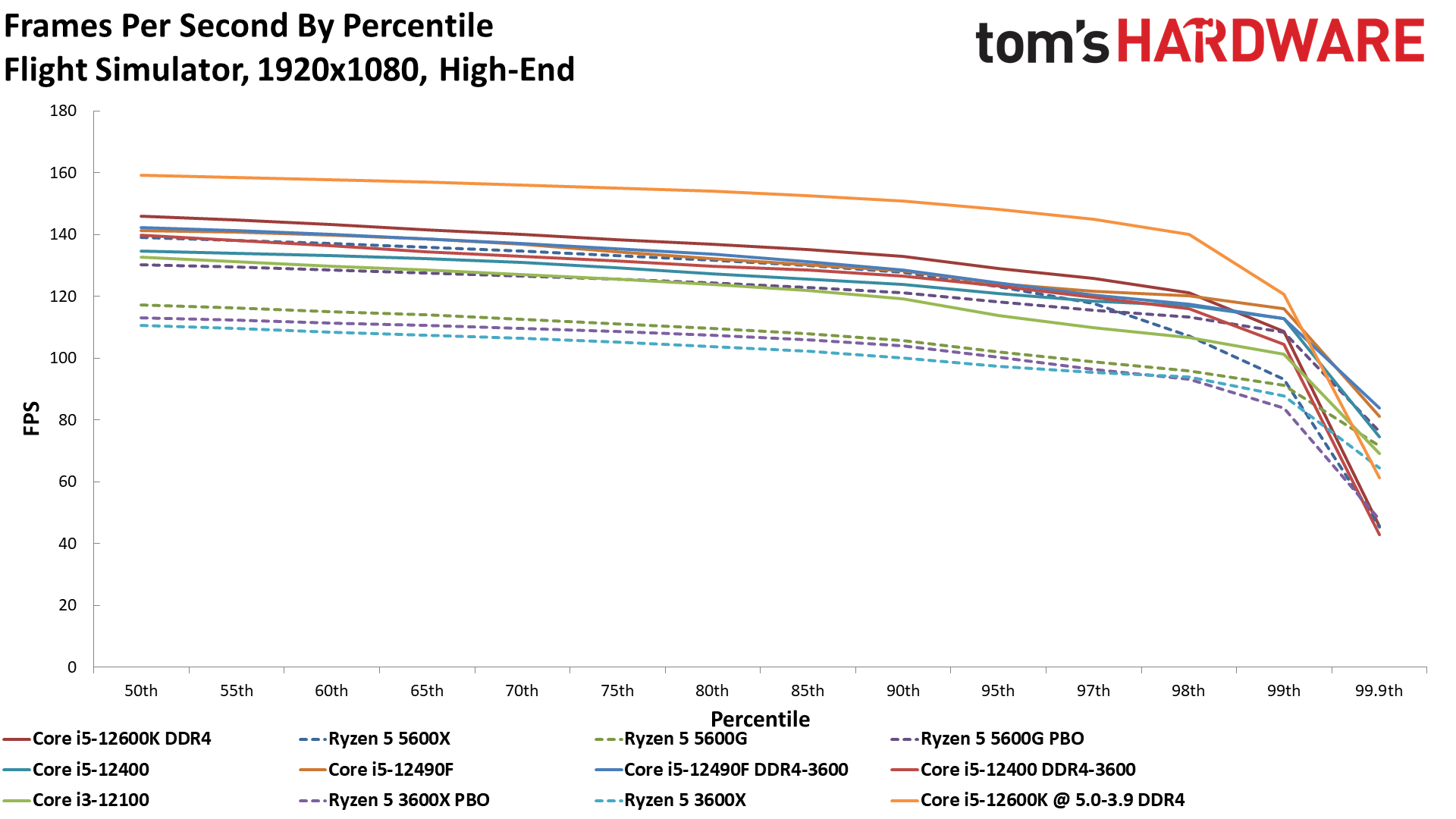
Red Dead Redemption 2 on Intel Core i5-12490F




Watch Dogs Legion on Intel Core i5-12490F
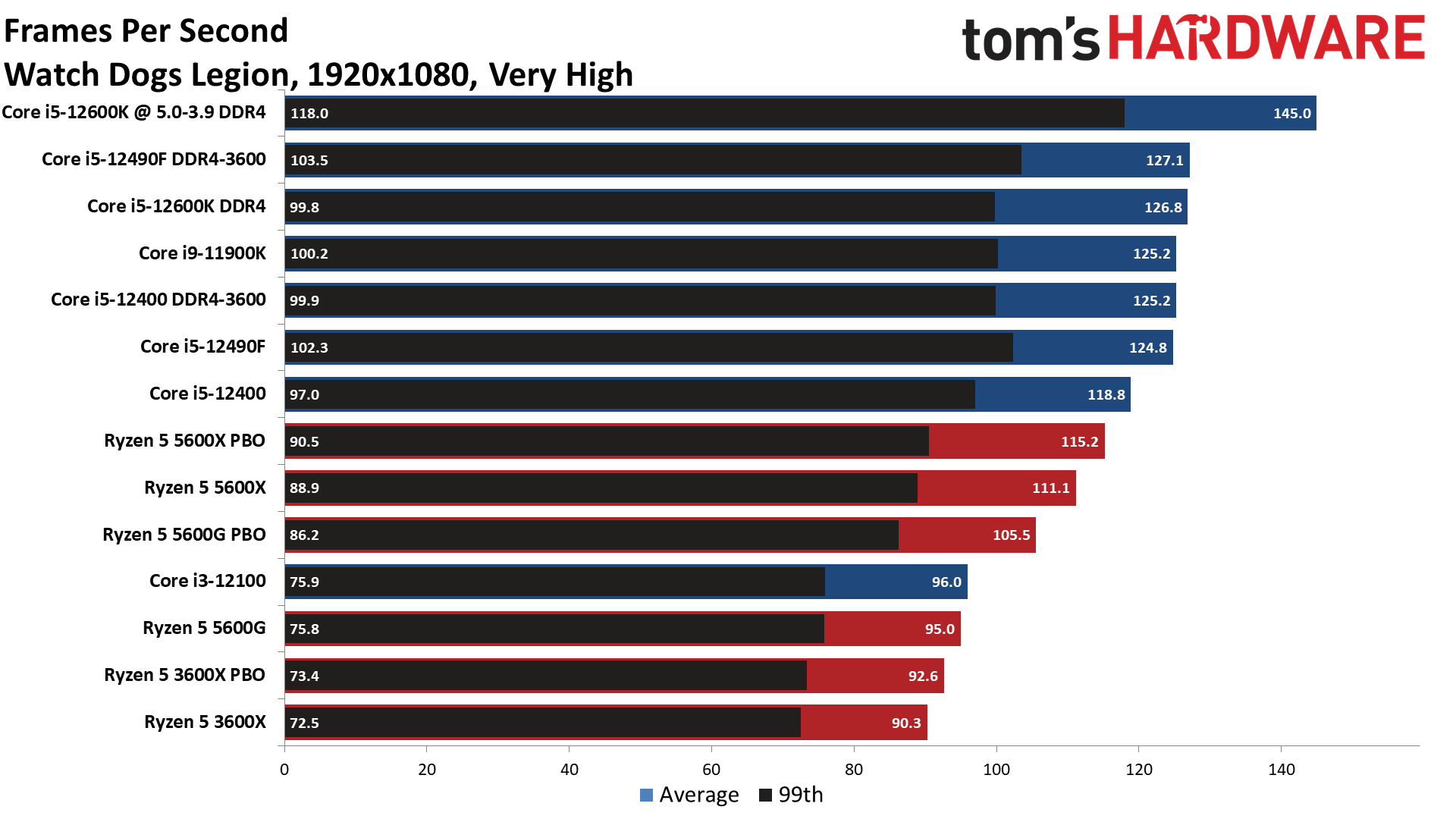
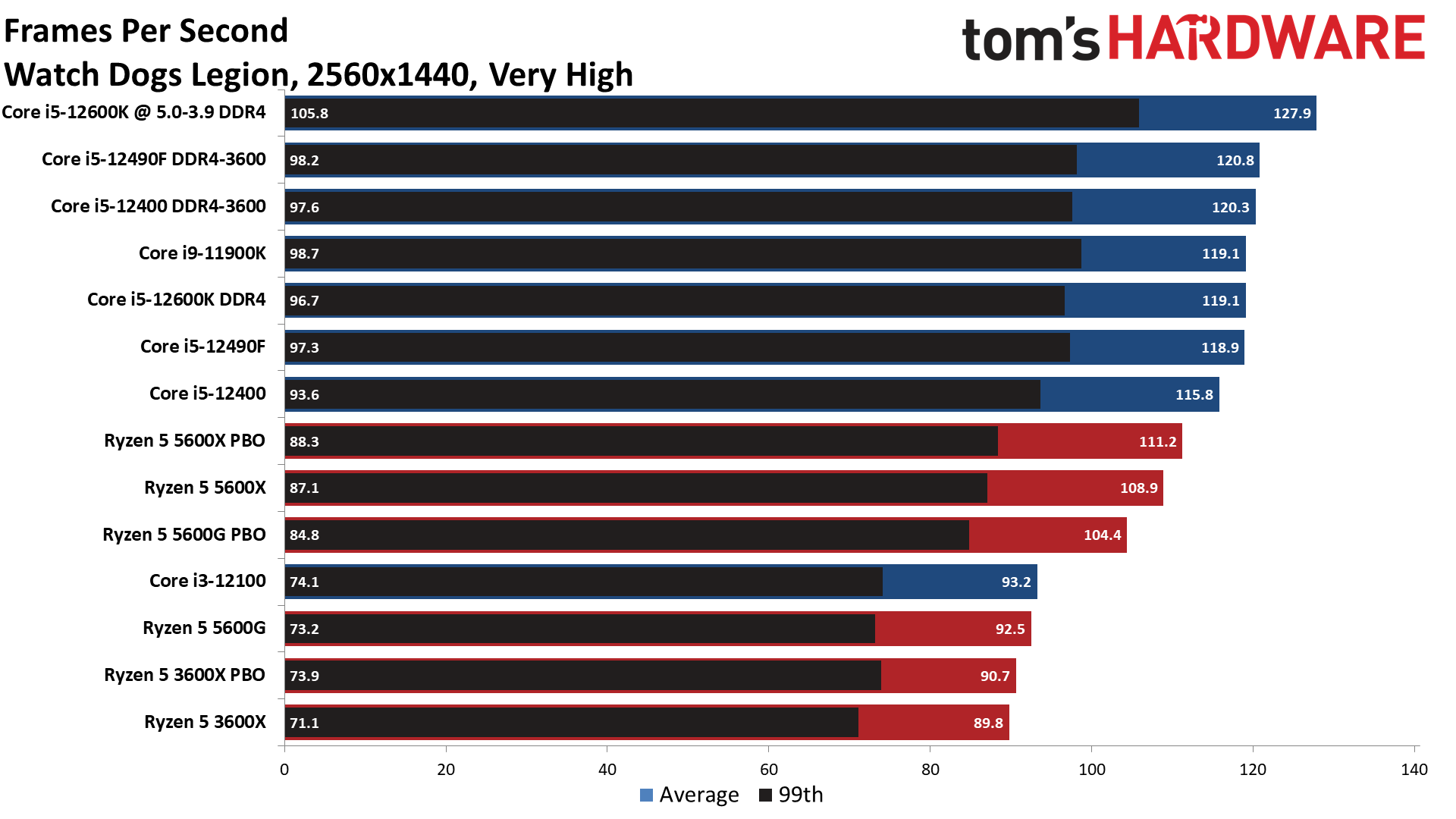
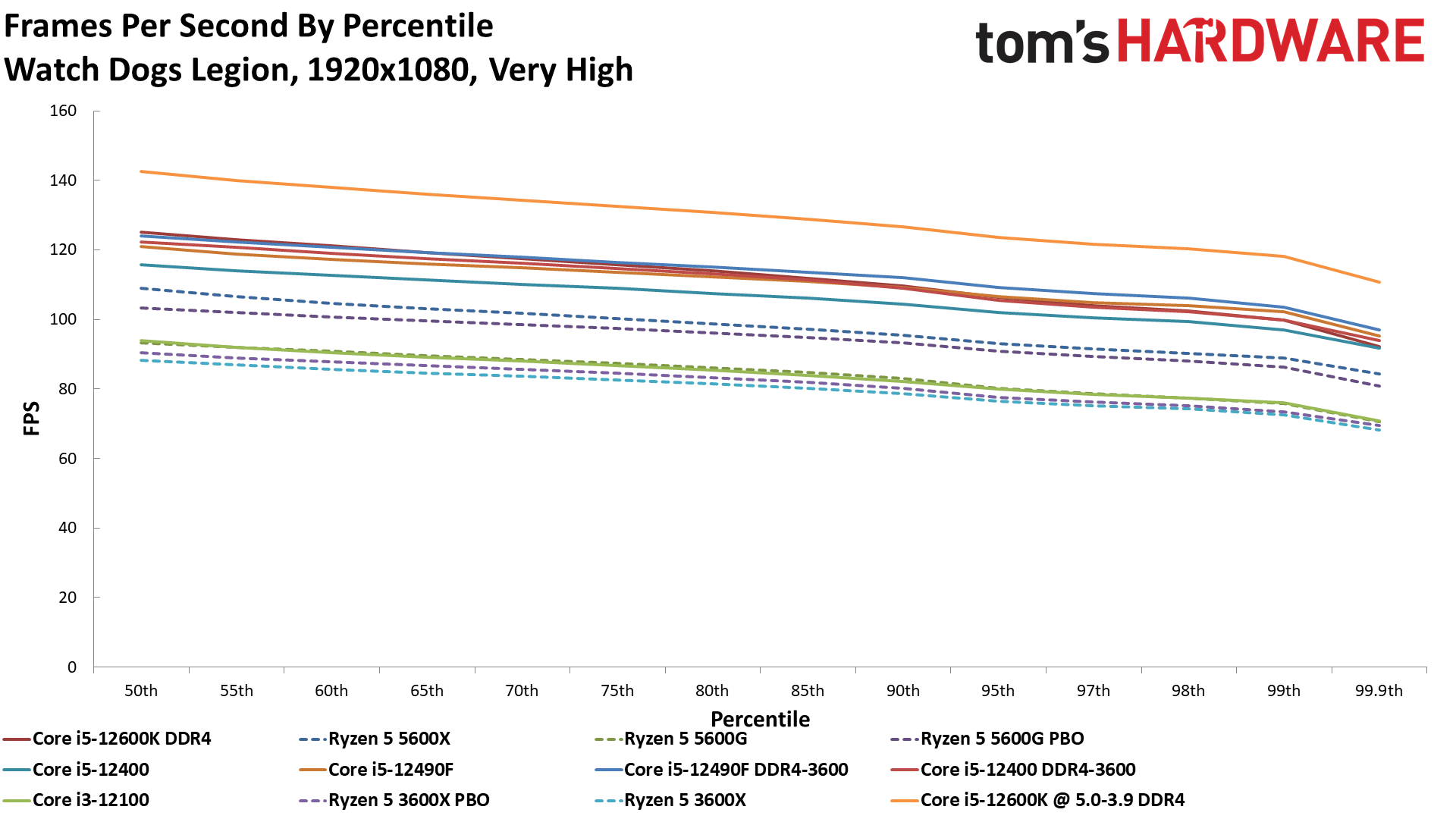

Intel Core i5-12490F Application Benchmarks — The TLDR


We can boil down productivity application performance into two broad categories: single- and multi-threaded. These slides show the geometric mean of performance in several of our most important tests in each category, but be sure to look at the expanded benchmark results further below.
The Core i5-12490F is just as impressive in our cumulative measure of single-threaded performance as you'd expect in light of its 200 MHz of extra dual-core boost over the 12500. The stock 12490F is 4% faster than the 12400, and removing the power limits for both chips gives the 12490F a 4.6% advantage. That's right in line with the 12490F's 4.7% increase in dual-core boosts.
Compared to Ryzen, the 12490F dominates in single-threaded applications, being 14% faster than the Ryzen 5 5600X and 20.3% faster than the Ryzen 5 5600G. After tuning, the 12490F is still 11.3% and 16.7% faster than the fully overclocked 5600X and 5600G, respectively. Not bad for a locked chip with slightly tuned memory and removed power limits.
In multi-threaded work, the Core i5-12490F essentially ties the Core i5-12400 in both stock and tuned configurations. Widening the scope to AMD comparables, we see that the 12490F remains impressive, but the margins are slimmer. The 12490F is a mere 2.6% faster in threaded work than the Ryzen 5 5600X at stock settings, but extends that to 4% after tuning. Bear in mind that these aren't the largest deltas, and as you'll see in the benchmarks below, the Ryzen 5 5600X carves out plenty of wins.
The Ryzen 5 5600G doesn't fare quite as well against the Core i5-12490F, though, as the Intel chip is 11.3% and 12.9% in stock and tuned trim, respectively.
The ~$250 Core i5-12490 is impressive in both single- and multi-threaded apps given its price point, but its problem remains the cheaper $199 Core i5-12490F. This chip has an exceptional price-to-performance ratio, especially given its integrated graphics and bundled cooler. Yes, the Core i5-12490F is measurably faster in almost all single-threaded workloads, but given that the chips are nearly identical in threaded applications, that advantage doesn't justify the markup.
| Tom's Hardware - Application Benchmarks | Single-Threaded | Multi-Threaded |
| Core i5-12600K DDR4 | 100% | 100% |
| Core i5-12490F | 94.3% | 73.5% |
| Core i5-12400 | 90.7% | 73.4% |
| Core i3-12100 | 88.9% | 53.5% |
| Core i5-11600K | 84.1% | 73.8% |
| Ryzen 5 5600X | 82.1% | 71.5% |
| Ryzen 5 5600G | 78.4% | 65.9% |
| Ryzen 3 3300X | 69.3% | 43.7% |
| Ryzen 5 3600X | 69.2% | 60.8% |
| Core i3-10100 | 64.5% | 37.3% |
Rendering Benchmarks on Intel Core i5-12490F


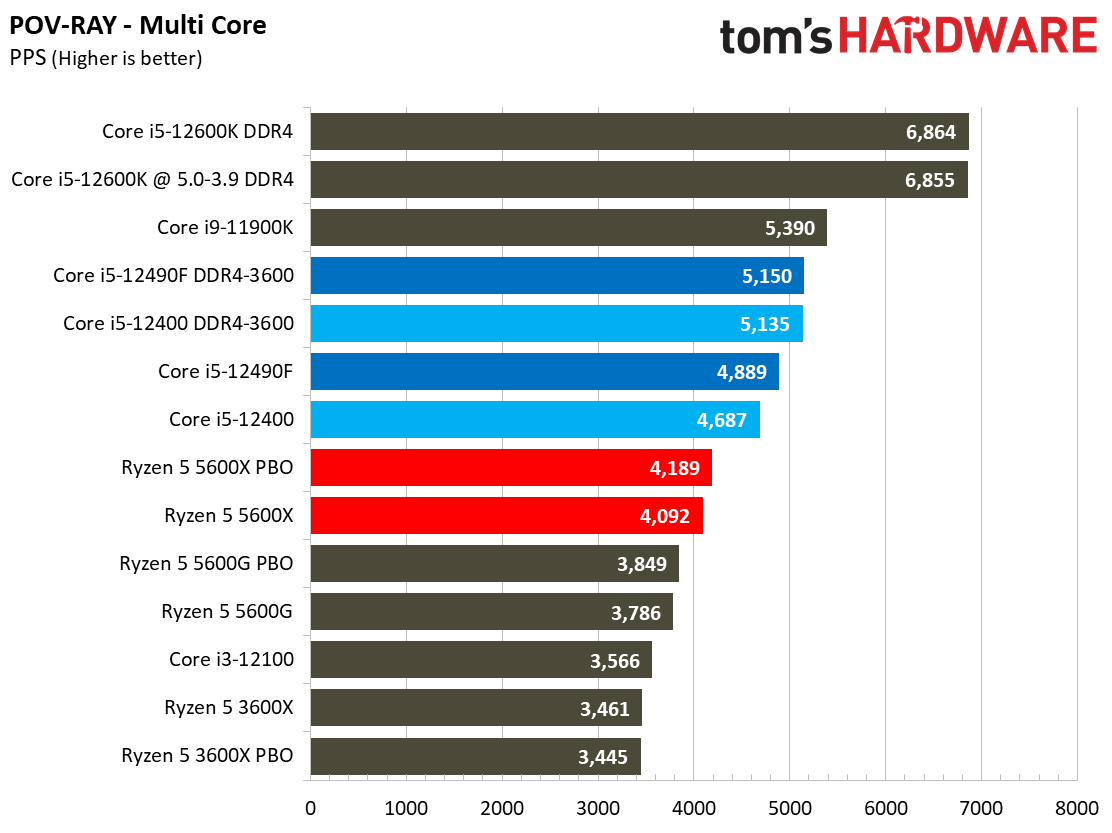
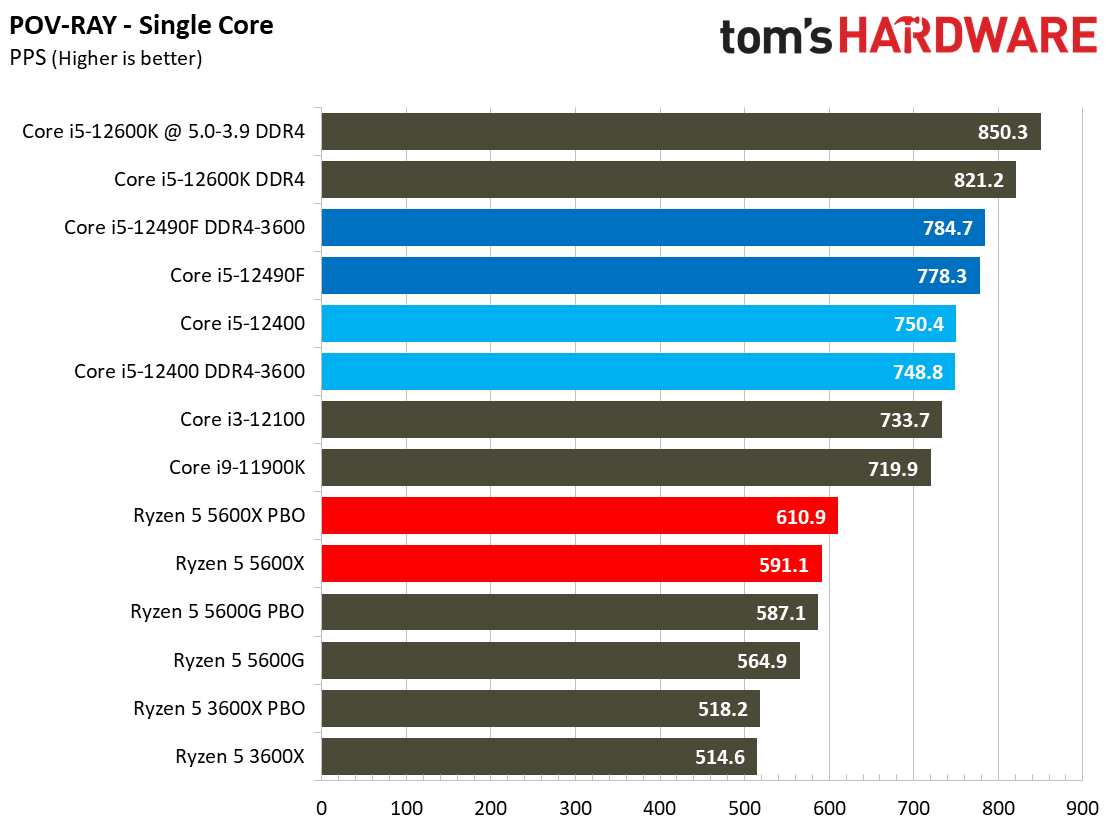



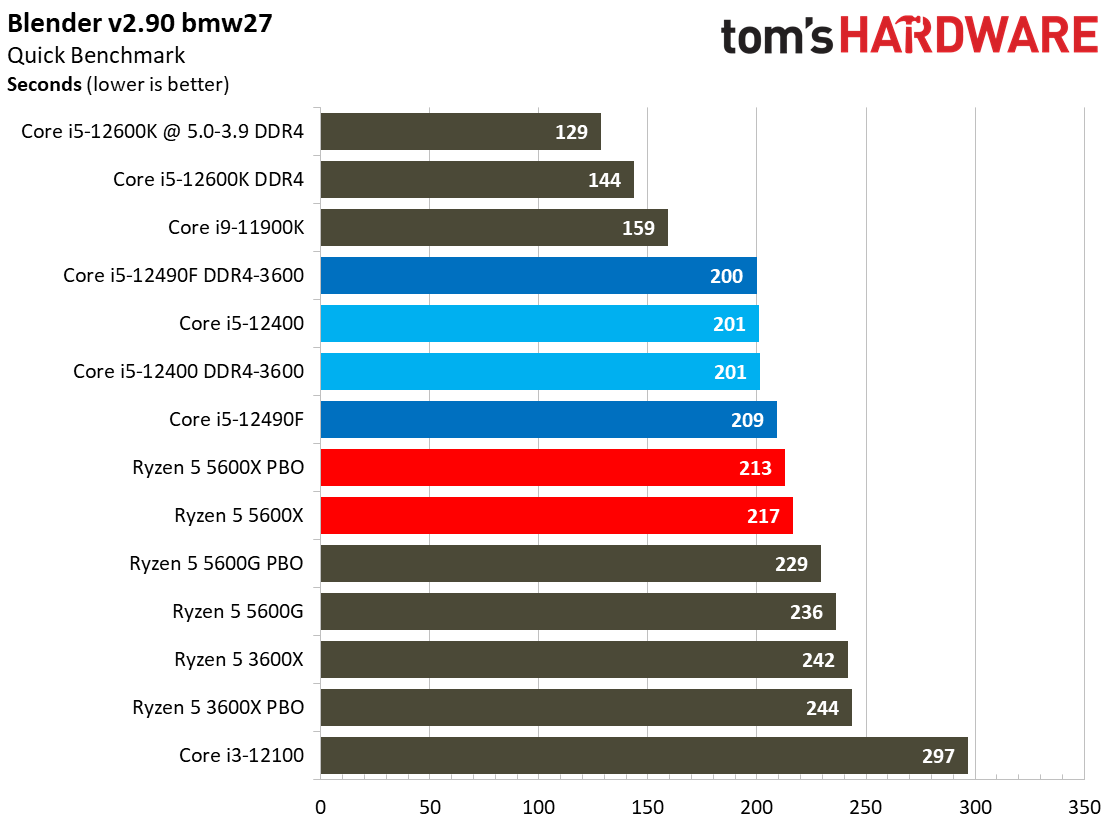



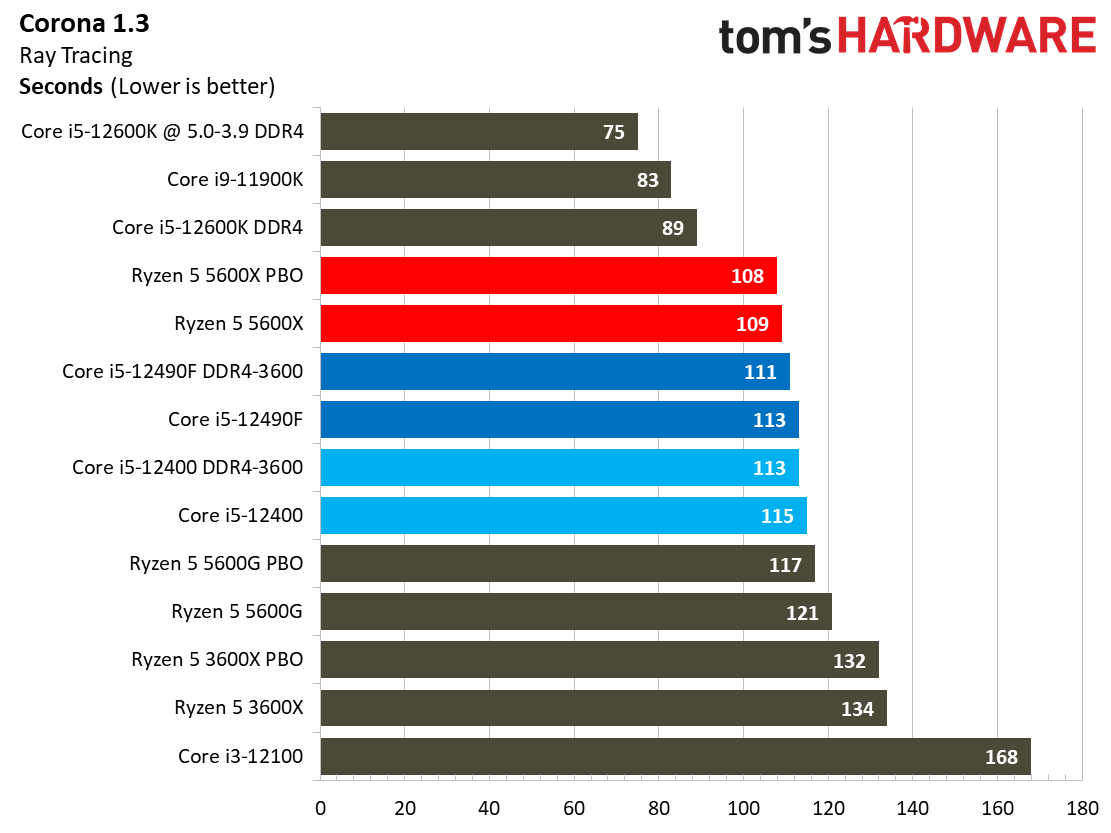

The Core i5-12490F is impressive in single-threaded rendering work, leading all competing Ryzen chips in Cinebench and POV-Ray benchmarks, not to mention the Core i5-12400.
However, the Core i5-12490F doesn't enjoy as much of a lead throughout our gamut of threaded rendering tests. The Core i5-12400 and the 12490F have the same all-core 4.0 GHz frequency, leading to some jockeying for position with slim performance deltas in the LuxMark, Corona, Cinebench, and Blender workloads. In fact, the latter finds the stock 12490F inexplicably trailing the stock 12400 by a few seconds in several of the renders, but regaining a slight lead after tuning. This is repeatable, perhaps pointing to either some artifact of the differing cache hierarchy that isn't entirely accounted for with this revision of Blender, or just sub-optimal tuning in the motherboard firmware.
Notably, the Ryzen 5 5600X is much more competitive in most of the threaded workloads, but its steep decline in lightly-threaded work takes a bit of the shine off for more diverse types of workloads that would involve both lightly- and heavily-threaded phases.
Encoding Benchmarks on Intel Core i5-12490F










Encoding tends to rely on single-threaded performance, like the quintessential examples we see in LAME and FLAC. Here the Core i5-12490F performs exactly as we would expect given its higher dual-core clock rates.
Moving to threaded work in HandBrake, we see that the Core i5-12490F again leads in its stock configuration, but removing the power limits for both the 12490F and the 12400 yields a tie, revealing the trend that the 12490F often won't have a significant advantage in threaded work if you simply remove the 12400's power limits. That same trend plays out in the threaded SVT-AV1 encoder tests, too.
Web Browsing on Intel Core i5-12490F




The ubiquitous web browser is one of the most frequently used applications. These tests tend to be lightly threaded, so a snappy response time is critical. Again, this plays right into the 12490F's clock speed advantage, so it predictably takes the lead over the 12400 in all of the tests.
Adobe Premiere Pro, Photoshop, and Lightroom on Core i5-12490F




We've integrated the UL Benchmarks Procyon tests into our suite to replace the aging PCMark 10. This new benchmark runs complex Adobe Premiere Pro, Photoshop, and Lightroom workflows with the actual software, making for a great real-world test suite.
Office and Productivity on Intel Core i5-12490F




Compilation, Compression, AVX Benchmarks on Core i5-12490F
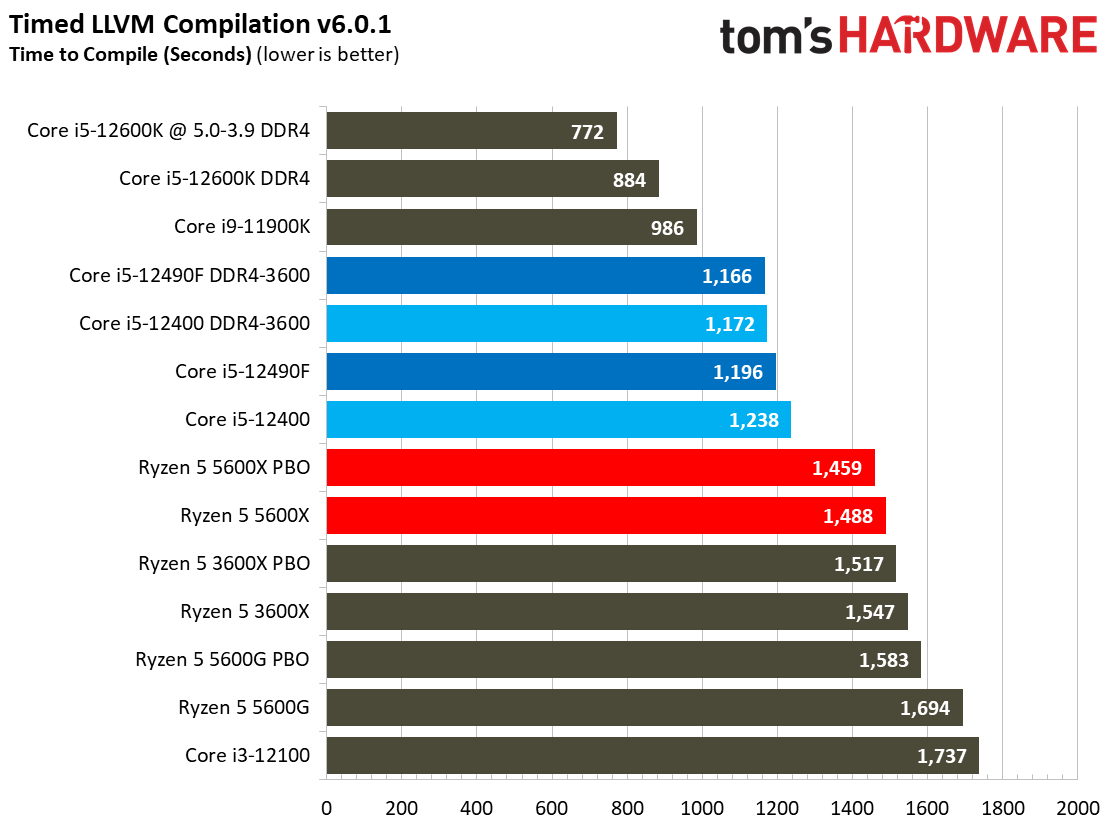




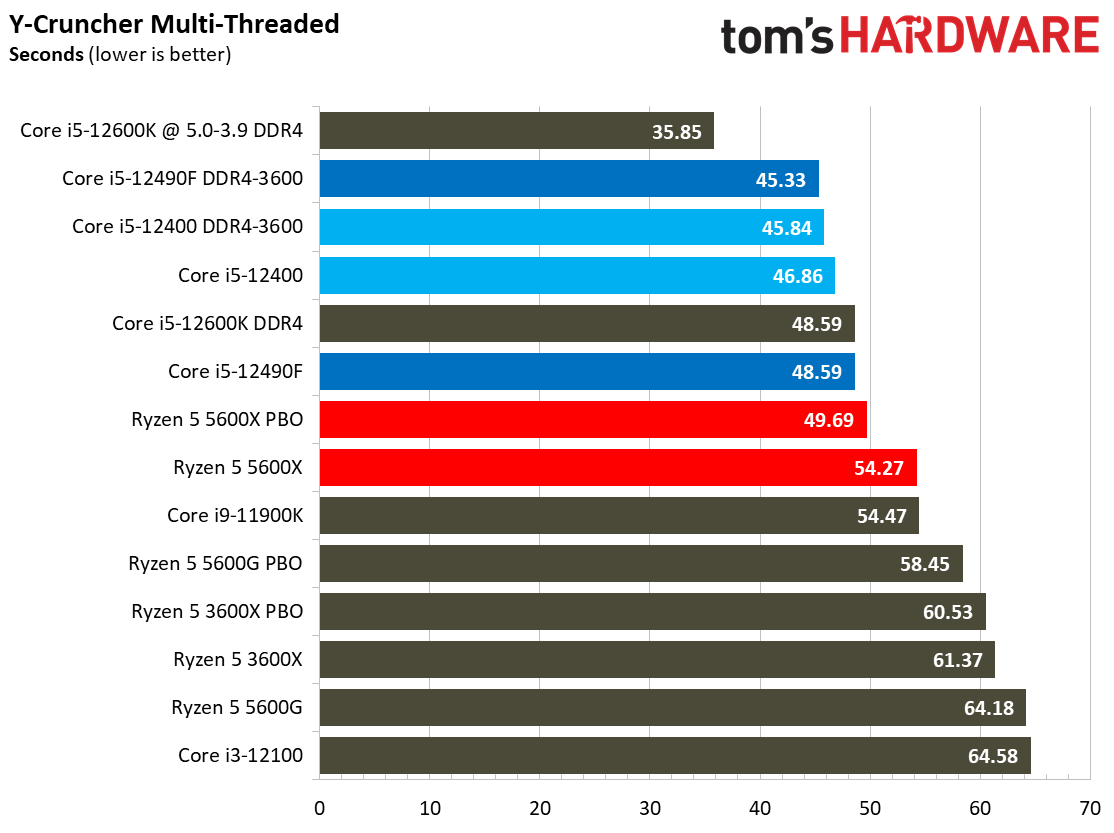

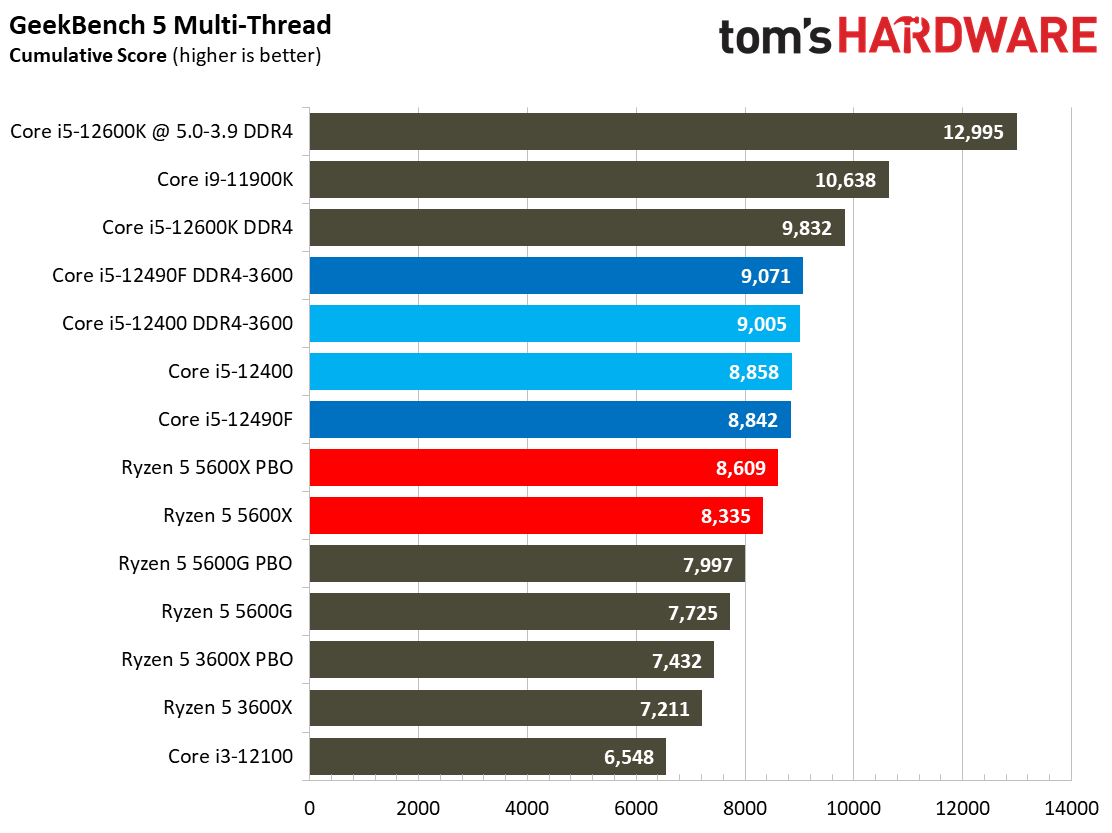


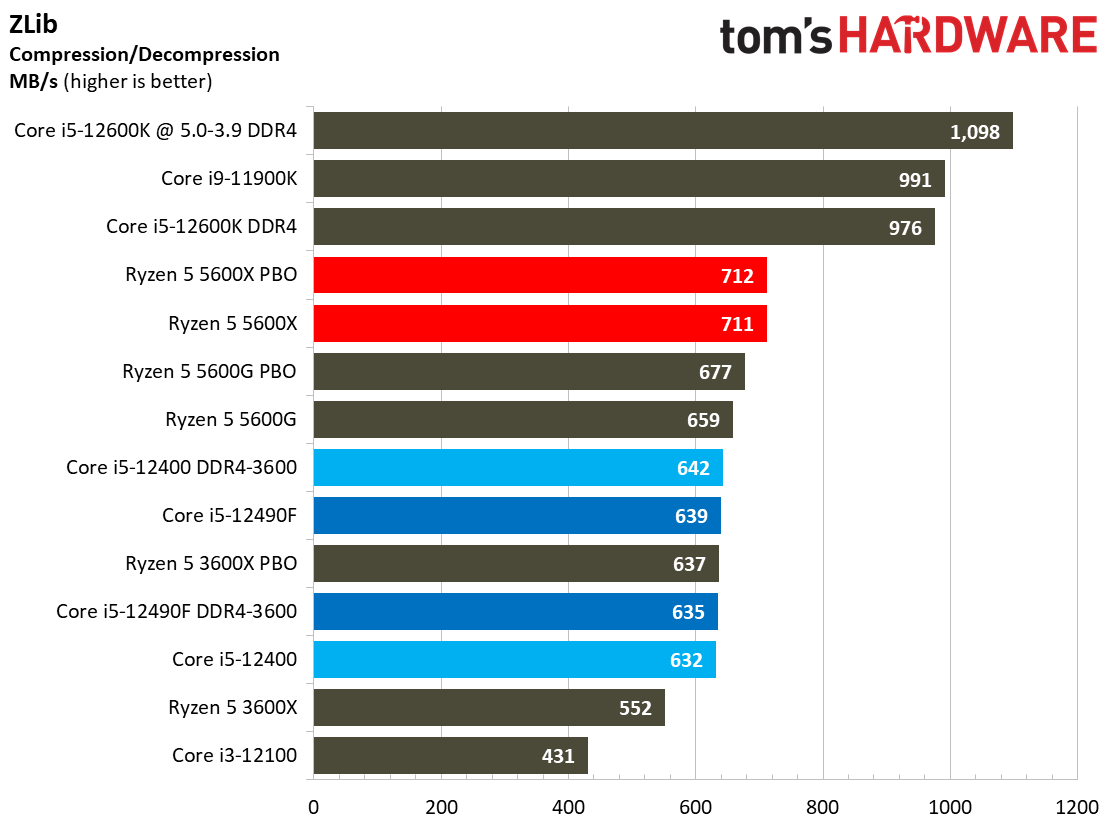

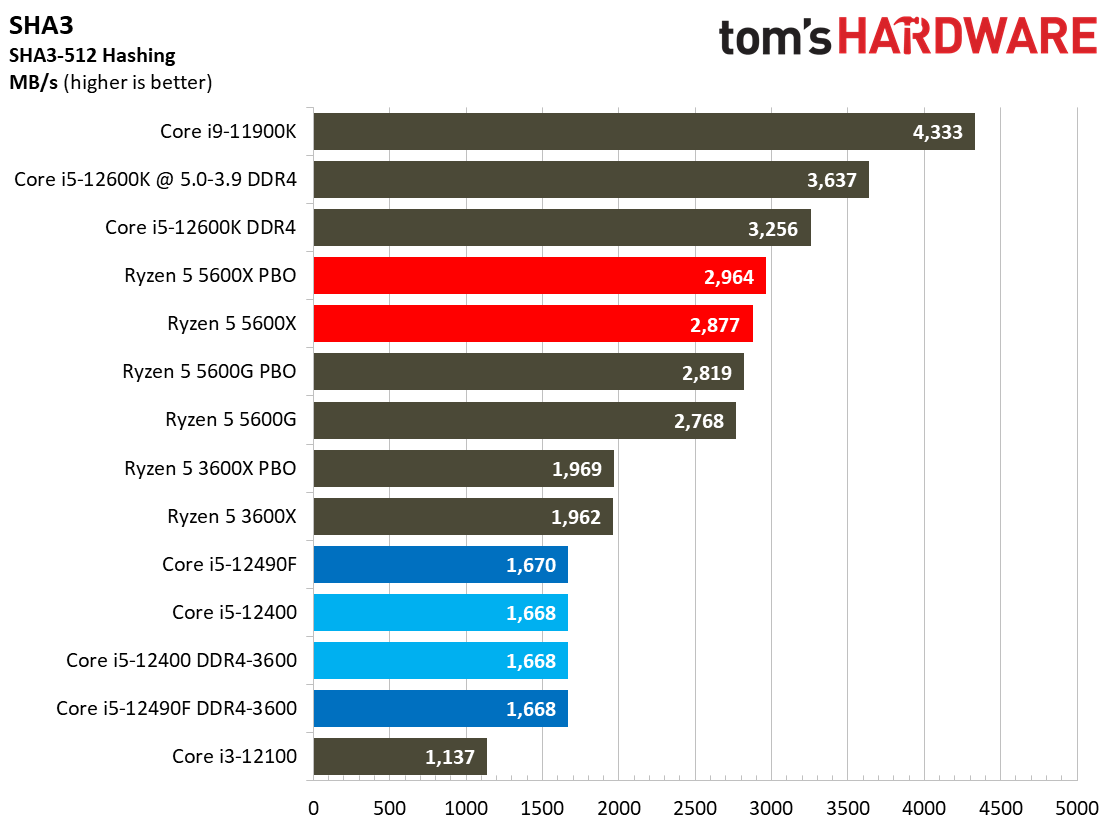

The Core i5-12490F easily beats the 12400 in tasks like the AVX-heavy single-threaded y-cruncher pi calculations and the synthetic GeekBench 5 tests, but the chip isn't nearly as impressive in the threaded iterations of those same benchmarks. In fact, we spot another outlier where the stock 12490F underperforms our expectations in the threaded y-cruncher benchmark.
We expected the Core i5-12490F to leverage its extra L3 capacity to lead over the Core i5-12400 in the exceedingly branchy code in the LLVM compilation workload and the massively parallel molecular dynamics simulation code in NAMD, and that happened at stock settings in both workloads. However, we don't see any meaningful advantage in the LLVM compilation workload after we lifted the power limits and tuned the RAM, suggesting the bottleneck lies elsewhere.
Intel Alder Lake Core i5-12490F Power Consumption and Efficiency
| Power (W) @EPS12V | 12490F NoPL (C0 - 8+8) | 12400 NoPL (C0 - 8+8) | 12400 NoPL (H0 - 6+0) |
| No AVX | 74.02 | 93.85 | 81.94 |
| Prime95 | 119.1267 | 149.72 | 123.57 |
Anecdotal evidence suggests that the H0 chips require less power because the 6+0 die is smaller and has less unused silicon that could potentially consume unneeded power. Here we can see that the 12400 with the big H0 die pulls far more power than the 12400 with the smaller C0 die, seemingly confirming that the smaller die consumes less power.
However, the Core i5-12490F also has the larger C0 die and pulls less power than both 12400 chips, sending us down a rabbit hole of testing to verify that our power measurements are correct.
Unfortunately, we only have two directly-comparable 12400s, so our sample size doesn't allow us to make any definitive statements on power consumption differences between the two die. However, the big takeaway here is that our testing suggests that factors such as VID and silicon quality can impact power consumption more than the differences between the different die revisions, as dynamic frequency and voltage adjustments (vCore) will vary based on silicon quality.
We prefer to use software monitoring tools like AIDA64 and HWinfo for our power measurements, as they scrape the power consumption measurements directly from the sensor loop, thus removing VRM inefficiencies from the values and showing us exactly how much power the processor itself consumes. That allows us to derive in-depth power consumption and efficiency metrics.
Unfortunately, the Core i5-12490F isn't well supported — it isn't even on official CPU compatibility lists for motherboards — so we weren't sure if the motherboard and/or software were feeding us the correct power telemetry. Faced with somewhat surprising results that the 12490F consumed less power than both 12400 revisions, due diligence dictated that we had to verify our results with testing at the physical layer.
We used Passmark's In-Line PSU tester to measure power consumption at the EPS12V connectors for these tests. Intercepting power at the EPS12V connectors (the eight-pin CPU connectors on the motherboard that supply the lion's share of power to the processor) doesn't measure the true amount of power flowing into the processor because VRM inefficiencies, typically in the range of ~10 to ~15% on high-end motherboards, come into play, thus inflating power consumption values. Modern processors also draw power from separate minor rails on the 24-pin connector for various functions, like memory controllers, graphics, and I/O interfaces, but it's impossible to split out the amount of power dedicated to the CPU from this connector. As a result, we don't include measurements from the 24-pin in the above values. Although this process involves a bit of fuzzy math due to VRM inefficiencies, using physical measurements like these allows us to verify the software-derived measurements that we use for in-depth power consumption and efficiency metrics.
Our testing at the physical layer confirms that the 12490F's power measurements are accurate, so we used our standard software-derived values from the sensor loop for our standard power testing below.
Our retail H0 die model refuses to run the spec'd DDR4-3200 memory in Gear 1 mode, restricting our ability to compare performance and latency. We're working on sussing that out. As a result, the remainder of our power measurements below only includes the 12400 with the C0 (8+8) die.









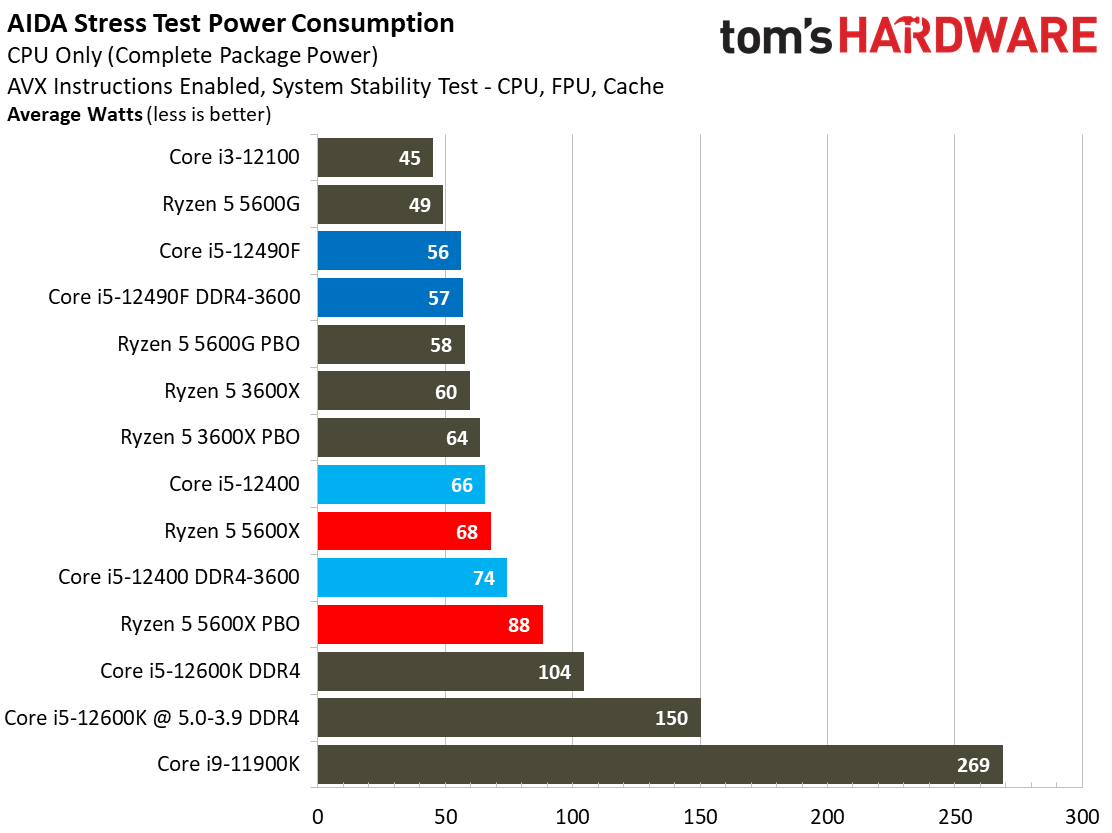

Yes, as we covered above, the Core i5-12490F pulls less power than the Core i5-12400 during our tests. Both chips have the same clock frequency during all-core workloads like we see in our synthetic AIDA tests, but the 12490F boosts higher during more sporadic workloads, like certain segments of the HandBrake tests. As you can see in our renders-per-day measurements, the Core i5-12490F is more efficient than the 12400, which comes as a byproduct of its higher performance within a slightly lower power envelope. Despite those higher clock speeds, the 12490F consumes less power than the 12400, suggesting this boils down to the chips having such similar specs that silicon quality has a bigger influence on power consumption. In other words, the 12490F appears to be a cherry chip.
The Intel Alder Lake chips still suck more power than AMD's Zen 3-powered Ryzen 5000 series chips, but pairing the Intel 7 process with the hybrid architecture brings big improvements, particularly in threaded work. The Zen 3-equipped Ryzen 5 5600G takes the crown as the most efficient chip in the test pool and often beats the Core i5 models in the average power measurements.


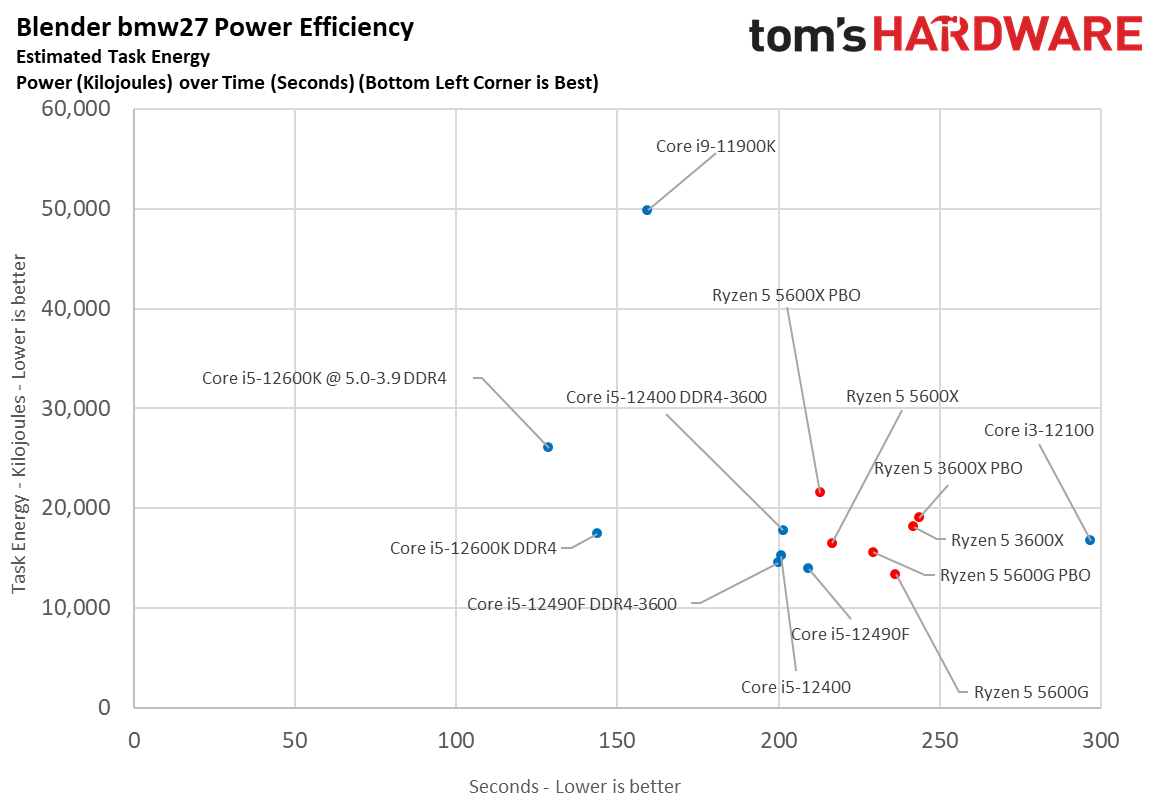
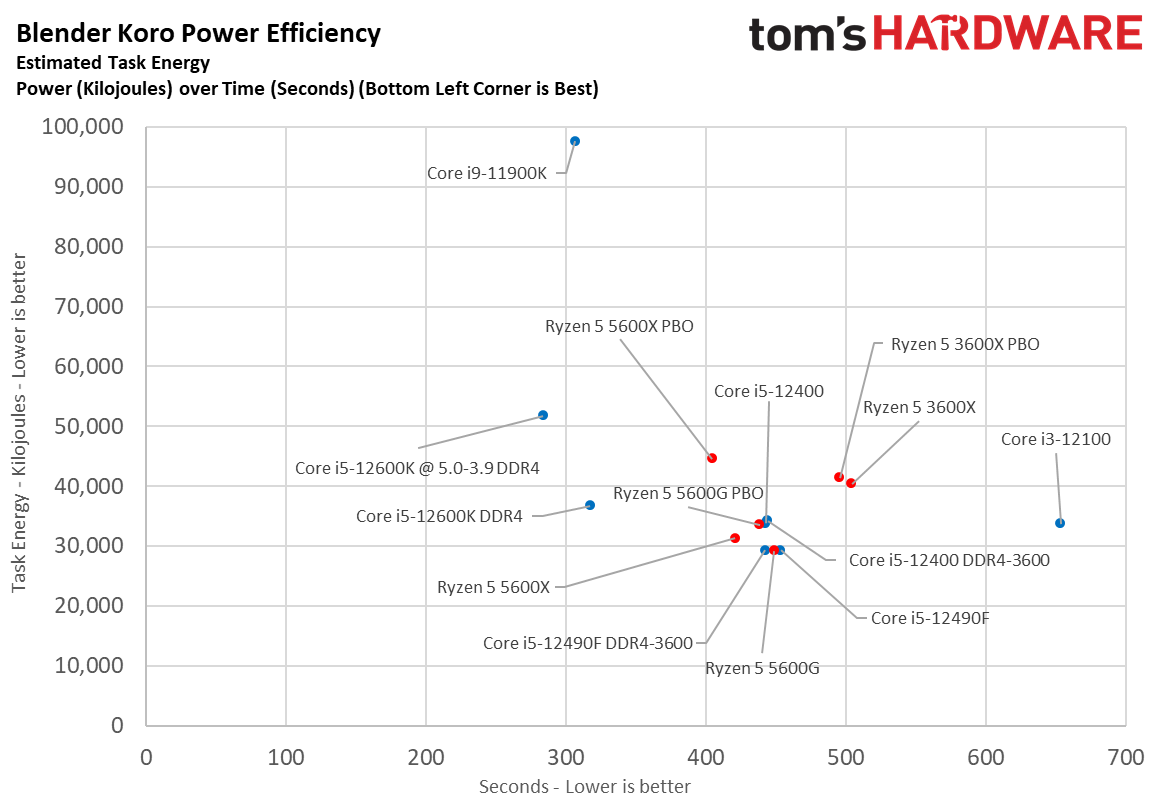
Here we take a slightly different look at power consumption by calculating the cumulative energy required to perform Blender and x264 and x265 HandBrake workloads, respectively. We plot this 'task energy' value in Kilojoules on the left side of the chart.
These workloads are comprised of a fixed amount of work, so we can plot the task energy against the time required to finish the job (bottom axis), thus generating a really useful power chart.
Bear in mind that faster compute times, and lower task energy requirements, are ideal. That means processors that fall the closest to the bottom left corner of the chart are best.
As you can see, the Core i5-12400 and 12490F consume less than half the power of the previous-gen Core i9-11900K during the HandBrake x264 test yet provides slightly faster performance after memory tuning. Naturally, we don't see such large improvements in all workloads, but the Core i5 Alder Lake chips do a great job of showcasing Alder Lake's impressive gen-on-gen power improvements — they often draw less power than all but the incredibly efficient Ryzen 5 5600G.
The China Exclusive Underwhelms

The Intel Core i5-12490F 'Black Edition' gaming chip offers 2MB more L3 cache than other locked Core i5 processors coupled with 200 MHz of extra boost clock frequency, but the chip is confined to the China market where it sells for a premium that makes it hard to recommend for most enthusiasts.
Below, we have the geometric mean of our gaming test suite at 1080p and 1440p and a cumulative measure of performance in single- and multi-threaded applications. We conducted our gaming tests with an RTX 3090, so performance deltas will shrink with lesser cards and higher resolution and fidelity settings.




In gaming, the Core i5-12490F is roughly ~2.5% faster than the 12400 at 1080p, but that delta shrinks to a mere 1% if you remove the power limits and overclock the memory for both chips. Part of the slim gain stems from the 12490F's clock speed distribution among the cores — while the 12490F does have an extra 200 MHz of clock speed over the 12400 in workloads that stress from one to four cores, both chips drop to the same all-core 4.0 GHz clock speed if five or more cores are active. That means the chips perform very similarly in threaded workloads, but the 12490F has an edge in lightly-threaded tasks and applications that benefit from its extra 2MB of L3 cache.
Today's games are increasingly multi-threaded, and the reality is that background services still run while you're gaming. As a result, it wasn't uncommon during our tests to find even mid-threaded gaming workloads migrating among the cores, thus keeping the chip at 4.0 or 4.2 GHz and reducing 12490F's clock speed advantage over the Core i5-12400. Additionally, the games in our test suite didn't experience any drastic performance increases from the extra 2MB of L3 cache.
We did see more impressive uplift in our cumulative measurement of single-threaded application tests, where the 12490F was 4% faster than the 12400. Additionally, removing the power limits for both chips gives the 12490F a 4.6% advantage — right in line with the 12490F's 4.7% increase in dual-core boosts.
However, the identical all-core boost clocks again held the Core i5-12490F back during our threaded workload suite, where the chip was essentially identical to the Core i5-12400 in the majority of workloads — particularly after removing the power limits. Yes, you can overclock the Core i5-12490F and other locked Intel processors on certain DDR5-equipped motherboards that have an external clock generator (read: expensive), but these boards are expensive and we have heard that Intel will deploy a microcode fix that disables this workaround in the coming weeks.
While the Core i5-12490F carves out some leads over the Core i5-12400 in various workloads, it doesn't improve Core i5's competitive positioning against the Ryzen 5 comparables. In fact, the Core i5-12490F's biggest problem is its little brother — the Core i5-12400. Despite AMD's recent price cuts, the Core i5-12400 remains the mainstream chip to beat.
Given the slim performance deltas we saw, the Core i5-12490F's increased cache capacity and extra clock speed aren't meaningful enough to justify the extra $50 you'll spend over the standard Core i5-12400. That's not to mention that you'll have to pay for international shipping, and you lose the bundled cooler and integrated graphics engine. On the other hand, if you don't mind sacrificing graphics, you can score the graphics-less Core i5-12400F for around $180 at retail — a deal that's hard to beat.
That calculus might change when AMD releases its new lower-end Ryzen 5000 chips on April 5 (the Ryzen 5 5600 looks particularly promising), so it would be wise to wait for reviews before you pull the trigger on a new chip.
The Core i5-12490F will still find some appeal among chip collectors and the black box is definitely an eye-catcher in the sea of blue Intel boxes, but the majority of enthusiasts are better served by mainstream offerings like the Core i5-12400 that offer similar performance at a much lower price point, ultimately leaving you with more money to spend on other system additives.
| Intel Socket 1700 DDR4 (Z690) | Core i5-12490F, Core i3-12100, Core i5-12600K, Core i5-12400 (C0) |
| Row 1 - Cell 0 | MSI Z690A WiFi DDR4 |
| Row 2 - Cell 0 | 2x 8GB Trident Z Royal DDR4-3600 - Stock: DDR4-3200 14-14-14-36 / OC: DDR4-3800 (12600K) / DDR4-3600 (12400/12490F) - All Gear 1 |
| Intel Socket 1200 (Z590) | Core i9-11900K |
| Row 4 - Cell 0 | MSI Z590 Godlike |
| Row 5 - Cell 0 | 2x 8GB Trident Z Royal DDR4-3600 - Stock DDR4-3200/2933 Gear 1 |
| AMD Socket AM4 (X570) | Ryzen 5 5600X, 5600G, 3600X |
| MSI MEG X570 Godlike | |
| Row 8 - Cell 0 | 2x 8GB Trident Z Royal DDR4-3600 - Stock: DDR4-3200 14-14-14-36 | OC/PBO: DDR4-3800 (5600X) DDR4-4400 (5600G),Second-gen DDR4-3600 |
| All Systems | Gigabyte GeForce RTX 3090 Eagle - Gaming and ProViz applications |
| Row 10 - Cell 0 | Nvidia GeForce RTX 2080 Ti FE - Application tests |
| 2TB Sabrent Rocket 4 Plus | |
| Silverstone ST1100-TI | |
| Row 13 - Cell 0 | Open Benchtable |
| Row 14 - Cell 0 | Arctic MX-4 TIM |
| Row 15 - Cell 0 | Windows 11 Pro |
| Cooling | Corsair H115i, Custom loop |
| Overclocking | All configurations with overclocked memory also have tuned core frequencies and/or lifted power limits. |
- MORE: Best CPUs for Gaming
- MORE: CPU Benchmark Hierarchy
- MORE: AMD vs Intel
- MORE: All CPUs Content

Paul Alcorn is the Editor-in-Chief for Tom's Hardware US. He also writes news and reviews on CPUs, storage, and enterprise hardware.
-
JamesJones44 I doubt they would be using the best possible silicon for this. My first thought was damaged/bad e-core cluster(s) with a 12600k under clocked. However, given the power draw, maybe it's some kind of frankenstein, using a mid cycle update, something closer to an Intel 7 process (err... 10 nm +++)Reply -
Exploding PSU Man, I miss playing games at internet cafes. 10 kids clumping together on one PC, everyone was a coach back then.Reply -
jacob249358 Cant they only play 2 hours a week at a designated time in China? Why are they getting exclusive cpus?Reply -
TerryLaze Reply
There are still a lot of people over there, 2 hours per person multiplied by billions, these are for internet Cafés not for home use.jacob249358 said:Cant they only play 2 hours a week at a designated time in China? Why are they getting exclusive cpus?